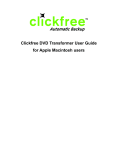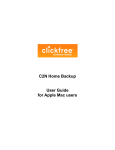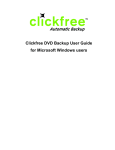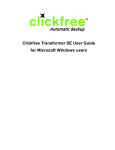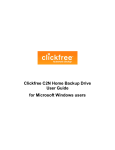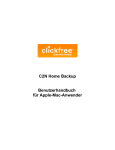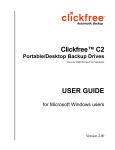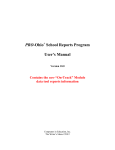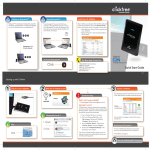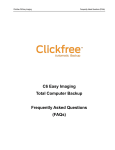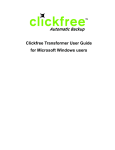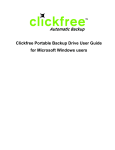Download Clickfree Backup Drive Computer Drive User Manual
Transcript
Clickfree Backup Drive User Guide for Apple Macintosh users Clickfree Backup Drive for Macintosh: User Guide Contents Contents INTRODUCING CLICKFREE BACKUP DRIVE 4 Main Features 4 Package contents 5 Definitions 5 BASICS 7 HOW DOES CLICKFREE WORK? 7 WHAT GETS BACKED UP? 7 Clickfree backs up content 7 Does Clickfree back up all of my content every time? 8 What content categories does Clickfree back up? 8 WHAT DO I NEED BEFORE I START? BACKING UP MY CONTENT HOW DO I START USING MY CLICKFREE BACKUP DRIVE? 8 9 9 ZERO EFFORT BACKUP – REALLY! 10 HOW DO I CHANGE HOW CLICKFREE DOES BACKUPS? 12 Choosing what to back up 12 Backing up all of the files in selected folders 13 Choosing categories of content to be backed up 13 Choosing folders to search for content 14 WHAT IF THERE IS NOT ENOUGH SPACE ON MY CLICKFREE BACKUP DRIVE? RESTORING MY CONTENT 16 17 WHAT IF MY COMPUTER’S INTERNAL HARD DISK STOPS WORKING, OR I WOULD LIKE TO TRANSFER MY 17 CONTENT TO A NEW COMPUTER? WHAT DO I NEED BEFORE I CAN USE CLICKFREE TO RESTORE MY CONTENT? 17 HOW DO I GET MY CONTENT BACK? 17 What gets restored, and to where? Copyright © 2009 Storage Appliance Corporation. 18 2 Clickfree Backup Drive for Macintosh: User Guide Contents HOW DO I LET CLICKFREE RESTORE DECIDE WHAT TO RESTORE AND WHERE? 18 HOW DO I CHANGE HOW CLICKFREE RESTORES CONTENT? 21 Restoring content 21 Choosing categories of content to be restored 21 Choosing where to restore content to 22 BROWSING & SEARCHING FOR MY FILES 25 Starting from the Welcome window 25 From the Backup Summary window 25 HOW DO I BROWSE MY BACKED-UP FILES? 26 ADVANCED TOPICS WHAT IF I HAVE MORE THAN ONE COMPUTER? How is backup different when I have more than one computer? WHAT IF I USE MORE THAN ONE BACKUP DRIVE? How do I make multiple backups? CLICKFREE TOOLS 27 27 27 27 27 27 Manage Backups 28 Master reset 29 Updating Clickfree software 30 HOW DO I CHOOSE INDIVIDUAL FILES FOR RESTORE? 31 WHAT DO I DO IF CLICKFREE DOESN’T START AUTOMATICALLY? 32 LEGAL STUFF Copyright © 2009 Storage Appliance Corporation. 33 3 Clickfree Backup Drive for Macintosh: User Guide Introducing Clickfree Backup Drive Introducing Clickfree Backup Drive Thank you for buying the Clickfree Backup Drive – the easiest way to keep the valuable information on your computer safe. Clickfree is an easy-to-use computer backup system that automatically searches for and backs up content stored on your computer. No hardware configuration or software installation is required. The backup procedure begins once the Backup Drive has been attached to your computer. Caution: Please remember that a backup is meant to be a second copy of your computer data, not the only copy of your data. Having two copies (redundancy) is what keeps your important data safe. Please use your Clickfree Backup Drive to keep a safe copy of your data. MAIN FEATURES Clickfree backup technology • • • Automatically starts when connected to your computer Does not require any software installation or setup For most users automatically backs up everything that matters Customizable backup options • • • Includes options for custom file types and full folder backup Still runs as Clickfree, even after customizing settings Remembers your customized settings for each user you use it with Multi-computer backup • Can hold the backups for as many users as you like, depending only on the available space on the Backup Drive Easy restore to same or other computer • • • Backed-up content can quickly and easily be restored You can just as easily ‘restore’ content to a different computer as to the original one This makes Clickfree a great way to move your content from your old computer to your new one How it backs up • The first time you connect a Clickfree Backup Drive to your computer it searches for, finds, backs up and organizes all of your important content • Each subsequent time you connect Clickfree to your computer, it just does an update: • Any new files since your last backup are added to the backup • Any files that were changed since your last backup are updated on the backup • Any files that were deleted from your computer since the last backup, are left on the backup Copyright © 2009 Storage Appliance Corporation. 4 Clickfree Backup Drive for Macintosh: User Guide Introducing Clickfree Backup Drive PACKAGE CONTENTS Your Clickfree backup package contains: • • • one Clickfree Backup Drive one USB cable to attach the Backup Drive to your computer one quick start guide DEFINITIONS Just to make sure that the user guide is clear, we’re going to define a couple of terms that are used throughout the guide. Back up and Restore Backing up is making copies of data so that a copy can be used to restore the original after the data is lost or destroyed. Backups are used to restore data after loss of or damage to your computer’s hard disk, and to restore files that have been accidentally deleted or corrupted. Making a backup of your content only copies it from your computer to your Backup Drive, and does not delete it from the computer’s hard disk. Restoring your content from a backup only copies it from your Backup Drive to your computer, and does not delete it from the Backup Drive. Important: Clickfree never erases or replaces content on your computer’s hard disk, unless you ask it to replace a file during restore. Clickfree never erases anything other than the backups it has performed. Any other data stored on your Backup Drive is left untouched and is never erased The only exception to this is if you previously used your Backup Drive with a non-Mac computer and saved files on it outside of Clickfree backups. Because you will need to reformat the Backup Drive for use with the Mac, all data on the disk will be lost. Be sure to copy valuable content before reformatting. And unless you ask it to remove backed-up content, Clickfree never erases or replaces content on your Backup Drive. Your Clickfree backups are also handy for moving or copying data from one computer to another. Content Normally you don’t use Clickfree to back up your applications or operating system, only the data that you have created or copied to your computer – music, photos, letters, emails etc. In this guide we refer to this data as content. File Information used by your computer and stored in a specific place on your hard disk. A file may be content, an application or part of an application, or information a program uses in some way. Copyright © 2009 Storage Appliance Corporation. 5 Clickfree Backup Drive for Macintosh: User Guide Introducing Clickfree Backup Drive Sometimes the relationship between content and file is clear: a photo or a letter is usually a single file. On the other hand, a single email message may be just a part of a large file that contains many messages, and related information such as email addresses, calendar events etc. However, you don’t need to be concerned about this because Clickfree takes care of all the details for you. Copyright © 2009 Storage Appliance Corporation. 6 Clickfree Backup Drive for Macintosh: User Guide Basics Basics HOW DOES CLICKFREE WORK? All you need to do to keep your projects, photos, videos, music etc. safe is to plug Clickfree in to your computer and let it work! No need to install software or to configure anything. Your computer knows when Clickfree has been plugged in, and it runs the backup program automatically each time it is connected. You can back up as many computers as you like with the Clickfree Backup Drive. The same thing happens each time you plug it into a new computer. And each of your backedup computers is kept separate on your Backup Drive. When Clickfree has finished backing up each computer, just unplug the Backup Drive and store in a safe place, or leave it plugged in and just push the Backup button at any time to perform another backup. If your data is lost for any reason (hard disk crash, laptop lost or stolen, content accidentally deleted), you’ll be really happy that you bought and used Clickfree. Your backed-up content is safe on your Clickfree backup, waiting to be restored when you have a working computer again. A Clickfree backup is also ideal for transferring your content from an old computer to a new one. Sometimes, for a variety of reasons, the program may not run by itself – it may need a little help. If this happens to you, don’t worry – it’s easy to get things going. We’ll show you how a little later. For details, see “What do I do if Clickfree doesn’t start automatically?” on page 32. WHAT GETS BACKED UP? CLICKFREE BACKS UP CONTENT At Clickfree we want to protect our customers from losing things that are irreplaceable. That’s why Clickfree finds and backs up all of the content from wherever it is on your computer. When it runs automatically, Clickfree backs up everything in your Home folder – this is where you normally put all of the content that you create or place in your computer. This includes photos, music, video, office documents, financial data, email, etc Most likely, this means that it will back up everything that matters to you right out of the box without you having to do anything but plug it in. Unless you explicitly ask it to do so, Clickfree does not back up the applications or the operating system. This means that your backup won’t need nearly as much space as the size of your computer’s hard disk since your content may only take up a small portion of your hard disk’s capacity, and we only back up the content. Copyright © 2009 Storage Appliance Corporation. 7 Clickfree Backup Drive for Macintosh: User Guide Basics DOES CLICKFREE BACK UP ALL OF MY CONTENT EVERY TIME? The first time you back up your computer Clickfree backs up the entire Home folder, which might take some time – it just depends on how much content you have. Each time you use Clickfree after that, it only backs up the new or changed content, so it will be much quicker. WHAT CONTENT CATEGORIES DOES CLICKFREE BACK UP? If you choose to back up by content category (rather than backing up your entire Home folder), Clickfree backs up content in these categories: • • • • • • • Office Documents – usually from word-processing programs such as AbiWord, Microsoft Word, NeoOffice, iWork, Adobe files Music – including CAF, CD audio, MP3, MIDI Videos – for example, AVI, MPEG, Shockwave Flash Photos – including common graphic formats such as JPEG, TIFF, and RAW Emails and Messages – including Apple Mail, Entourage, Thunderbird Favorite Websites – internet shortcuts and address books Other – including Stuffit and hqx files, XML, and comma-separated values files Want to know more? You can look at the details by following the steps in “How do I change how Clickfree does backups” on page 12 without making any changes. WHAT DO I NEED BEFORE I START? All you need to start your backup is the Clickfree Backup Drive and the included USB cable. Before you start your first Restore, you should read through the “Restoring my content” chapter of this manual. • For Clickfree to work, your computer needs to be running Mac OSX 10.5 Leopard on an Intel processor In addition you need: • • One free USB port on your computer At least 100 MB of free space on your computer Copyright © 2009 Storage Appliance Corporation. 8 Clickfree Backup Drive for Macintosh: User Guide Backing up my content Backing up my content HOW DO I START USING MY CLICKFREE BACKUP DRIVE? ♦ To start using your Clickfree Backup Drive: 1. Make sure that your computer is switched on and has finished starting up. 2. Log in, if that is what you normally do. 3. Attach the Clickfree Backup Drive to your computer by connecting one end of the USB cable to the drive and the other end to a USB port on your computer. USB ports usually looks like this: . Wait for the Clickfree window to appear. You may have to wait up to a full minute for your computer to recognize the Clickfree Backup Drive. 4. The first time you connect your Clickfree Backup Drive, the Start Clickfree Backup window appears on the desktop. 5. Double-click the icon to start the backup. Every time after the first time the backup starts by itself. Copyright © 2009 Storage Appliance Corporation. 9 Clickfree Backup Drive for Macintosh: User Guide Backing up my content You then see a dialog that allows you to choose to make the Backup Drive work with the Mac by formatting it as HFS. Click . Clickfree then reformats the Backup Drive. When the Clickfree backup starts to run, a Welcome window appears and shows the number of seconds left before the backup starts automatically: Note: The View Files and Restore buttons do not appear until you have backed up content on your Backup Drive. ZERO EFFORT BACKUP – REALLY! Unless you stop the countdown by clicking a button, at the end of the countdown period Clickfree starts the backup. • If you want to let Clickfree decide what needs to be backed up from where, then you’re done: just relax and let Clickfree work. Without any effort on your part, Clickfree is safeguarding your valuable content! For details, see “What gets backed up?” on page 7. Copyright © 2009 Storage Appliance Corporation. 10 Clickfree Backup Drive for Macintosh: User Guide • Backing up my content If you want to make changes to how backup is done, click Options and see “How do I change how Clickfree does backups” on page 12 Clickfree displays some windows to show progress: The Backup Summary window shows you how many files in each category were backed up this time (New column) and from all backups for this user, including this one (Total column). The Space Used column shows the amount of space that files from all backups take up on the Backup Drive. When you see the Backup Summary window, you can browse your backed up files in a Finder window (see “Browsing & searching for my files” on page 25, or simply unplug the Clickfree Backup Drive and store it in a safe place, or leave it plugged in and just push the Backup button at any time to perform another backup. Copyright © 2009 Storage Appliance Corporation. 11 Clickfree Backup Drive for Macintosh: User Guide Backing up my content HOW DO I CHANGE HOW CLICKFREE DOES BACKUPS? You can decide whether Clickfree backs up complete folders, or backs up content by category (for example, Office Documents). The default is to back up your complete Home folder. If you choose to back up content by category, you can choose: • • Note: ♦ The categories of content Clickfree backs up Where Clickfree looks for this content Changes you make to how Clickfree does backups are “sticky”: they are stored and applied again to later backups for this user unless you modify them. To review or change what gets backed up: 1. Follow steps 1 to 4 of the procedure “How do I start using my Clickfree Backup Drive?” on page 9. 2. Before the countdown reaches zero, click Options. The Options / Tools window is displayed: CHOOSING WHAT TO BACK UP 3. You can either back up all of the files in selected folders (for example, your Home folder), or you can choose the categories of content to back up (for example, Office Documents, Photos, and Videos), and the folders to search for these categories. • • To back up all of the files in selected folders, make sure that the radio button to the left of (Recommended) Select this option to backup all files for… is selected . If it isn’t, select it, and go to step 4. To choose categories and folders to search, make sure that the radio button to the left of Backup by categories is selected . If it isn’t, select it, and go to step 6. Copyright © 2009 Storage Appliance Corporation. 12 Clickfree Backup Drive for Macintosh: User Guide Backing up my content BACKING UP ALL OF THE FILES IN SELECTED FOLDERS Your home folder is selected by default. 4. Choose which folders you want Clickfree to back up completely. You can add and remove folders. Click the Advanced button near the top right of the Clickfree window, then • To add a folder a. Click b. Navigate to the folder to be added c. Click Open • To remove a folder: a. Select the folder to be removed b. Click Note: You must choose at least one folder. 5. When you are finished choosing folders, click OK twice, and go to step 9. CHOOSING CATEGORIES OF CONTENT TO BE BACKED UP All of the categories are selected by default. 6. Choose the categories of content to be backed up, for example, Office Documents, Photos, and Videos. • To include a category, for example, Photos, in the backup, make sure that the box to • the left of the category name is checked . If it isn’t, click the box to check it. You can add and remove the checkmark by clicking in the box. To exclude a category, for example, Music, from the backup, make sure that the box to the left of the category name is unchecked to uncheck it. Note: . If it is checked, click the box You must choose at least one category. Copyright © 2009 Storage Appliance Corporation. 13 Clickfree Backup Drive for Macintosh: User Guide Backing up my content CHOOSING FOLDERS TO SEARCH FOR CONTENT Your home folder is selected by default. 7. Choose where you want Clickfree to search for the categories you chose earlier. You can add and remove folders Click the Advanced button near the bottom right of the Clickfree window, then • To add a folder a. Click b. Navigate to the folder to be added c. Click Open • To remove a folder: a. Select the folder to be removed b. Click Note: You must choose at least one folder. 8. When you are finished choosing folders, click OK twice, and continue with step 9. 9. When you have made your choices, click Start to begin the backup. Clickfree searches for content to back up Before actually backing up any content, Clickfree adds up the sizes of the files in the complete folders you chose, or searches the folders you chose for your chosen categories of content and adds up the sizes of all of the content it finds: See “What if there is not enough space on my Clickfree Backup Drive?” on page 16. Copyright © 2009 Storage Appliance Corporation. 14 Clickfree Backup Drive for Macintosh: User Guide Backing up my content Clickfree backs up your content If there is enough space on your Backup Drive, Clickfree then backs up the content you chose to your Backup Drive: At the end of the backup, a Backup Summary window is displayed: The Backup Summary window shows you how many files in each category were backed up this time (New column), and from all backups including this one, for this user (Total column). The Space Used column shows the amount of space that files from all backups for this user take up on the Backup Drive. When you see the Backup Summary window, you can browse your backed up files in a Finder window (see “Browsing & searching for my files” on page 25), or simply unplug the Clickfree Backup Drive and store it in a safe place, or leave it plugged in and just push the Backup button at any time to perform another backup. Copyright © 2009 Storage Appliance Corporation. 15 Clickfree Backup Drive for Macintosh: User Guide Backing up my content WHAT IF THERE IS NOT ENOUGH SPACE ON MY CLICKFREE BACKUP DRIVE? While Clickfree is searching for content to back up, it adds up the amount of disk space needed and compares that with the free space on the Backup Drive. If there is not enough free space for your content, Clickfree prompts you to go to the backup options window and adjust your settings: For example, you might want to reduce the number of file categories being backed up. See “How do I change how Clickfree does backups” on page 12 for details. As an alternative, if you have backups from an old computer or user that you don’t need to keep any more, you could remove the old computer or user. For details, see “Manage Backups” on page 28. Copyright © 2009 Storage Appliance Corporation. 16 Clickfree Backup Drive for Macintosh: User Guide Restoring my content Restoring my content WHAT IF MY COMPUTER’S INTERNAL HARD DISK STOPS WORKING, OR I WOULD LIKE TO TRANSFER MY CONTENT TO A NEW COMPUTER? All computer hard disks fail eventually, sometimes without warning. Occasionally, computers suffer damage that affects the hard disk. Sometimes, laptop computers get lost or stolen. Sometimes, also, you may delete content by mistake. When these things happen, other computer users may lose valuable, sometimes irreplaceable, data. But if you lose content you’ll be really happy that you bought and used Clickfree. Your backed-up content is safe on your Clickfree backup, and can be restored when you have a working computer again. A Clickfree backup is also ideal for transferring your content from an old computer to a new one. WHAT DO I NEED BEFORE I CAN USE CLICKFREE TO RESTORE MY CONTENT? Before you can restore your content, your computer needs to be working – at the very least it needs to be able to start up and display the desktop. Of course, you can ‘restore’ your content to any computer that meets the system requirements (see “What do I need before I start?” on page 8), not just to the computer whose content you backed up. The easiest way to copy backed-up content to another computer is to plug the Clickfree Backup Drive in to the other computer. When the Clickfree application launches, just click the Restore button at the bottom of the countdown window. HOW DO I GET MY CONTENT BACK? To get your content back you don’t need to do much more than you did to back the content up – it just takes a couple of clicks. As with Clickfree backup, you can either make some choices – whether to restore all, or just selected content, and where the content is restored to – or you can allow Clickfree to make the choices for you. Copyright © 2009 Storage Appliance Corporation. 17 Clickfree Backup Drive for Macintosh: User Guide Restoring my content WHAT GETS RESTORED, AND TO WHERE? When Clickfree restore runs without you changing any options, it restores all of the content that was backed up, and puts it in the Restored Files folder under your Home folder. If you prefer, you can easily tell Clickfree to restore your files to any place on your computer’s hard disk that is convenient for you. For details, see: • • “How do I let Clickfree restore decide what to restore and where?” on page 18 “How do I change how Clickfree restores content?” on page 21 HOW DO I LET CLICKFREE RESTORE DECIDE WHAT TO RESTORE AND WHERE? You can allow Clickfree to make the decisions about what to restore and to where, but you need to confirm what Clickfree plans to do. ♦ To let Clickfree decide what to restore and to where: 1. Make sure that your computer is switched on and has finished starting up. 2. Log in, if that is what you normally do. 3. Connect the Clickfree Backup Drive to your computer by connecting one end of the USB cable to the drive and the other end to a USB port on your computer. Clickfree starts up just as it did when you used it to back up your content. 4. Wait for the Clickfree window to appear – this may take up to 60 seconds. The Clickfree Welcome window appears with the countdown, just as it did when you used it to back up your content. But this time you are not going to allow Clickfree to start the backup. Because you have backed-up content on your Backup Drive, the countdown window now shows buttons at the bottom to allow you to View Files and Restore files. Copyright © 2009 Storage Appliance Corporation. 18 Clickfree Backup Drive for Macintosh: User Guide Restoring my content 5. Before the countdown gets to zero, click Restore. The What to restore window appears. Note that all of the categories that have backed-up content are checked off in the Categories column. 6. Before you click Continue to restore all of your content, or select categories to be restored, look at the user name in the Please select the User you would like to restore box. If your Backup Drive contains backups created for your user name, the Please select the User you would like to restore box by default contains your user name, and, unless you change it, the content to be restored will come from your user account. 7. Click the arrow at the right of the Restore From box: The list that appears contains the names of all of the users whose files have been backed up on your Backup Drive. 8. Select the name of the user whose content you want to restore. Note: To restore content from more than one user simply repeat the restore process choosing a different user each time. 9. Since you are letting Clickfree restore all of your content, simply click Continue. Copyright © 2009 Storage Appliance Corporation. 19 Clickfree Backup Drive for Macintosh: User Guide Restoring my content 10. Since you are letting Clickfree restore files to the default folder, simply click Continue. As Clickfree restores your content, it shows you what is happening and how far it has gotten in the process. 11. Before it overwrites an existing file on your computer with one of the same name from the backed-up files, Clickfree asks if you want to replace the existing file with the one from the backup: 12. You can choose to: • • • • • • Keep both copies of this one file – click Keep Both. Clickfree renames the backedup file by adding ‘ copy’ to the end of the file name, then restores the renamed file. Keep both copies of all same-name files – check Do this for all duplicate files and click Keep Both. Clickfree, without asking you, renames the remaining backed-up files by adding ‘copy’ to the ends of the file names, then restores the renamed files. Not replace this one file – click Skip Not replace any same-name files – check Do this for all duplicate files and click Skip. Clickfree skips all remaining same-name files without asking you. Replace just this file – click Replace Replace all same-name files – check Do this for all duplicate files and click Replace. Clickfree replaces all remaining same-name files without asking you. If two files have the same size (KB) and same date/time modified, it is likely safe to skip. Copyright © 2009 Storage Appliance Corporation. 20 Clickfree Backup Drive for Macintosh: User Guide Restoring my content 13. When all of your content has been restored, Clickfree tells you that it is done. 14. To open a Finder window at the restore folder, click the button below Your files have been restored to. 15. To finish, simply unplug the Clickfree Backup Drive and store it in a safe place, or leave it plugged in and just push the Backup button at any time to perform another backup or restore. Note: Your content has not been deleted from your Clickfree backup: it is still safe on the Backup Drive. HOW DO I CHANGE HOW CLICKFREE RESTORES CONTENT? By making choices at several steps in the restore process you can affect which content is restored and where it is restored to. RESTORING CONTENT ♦ To change how Clickfree restores content: 1. Follow steps 1 to 8 of the previous section “How do I let Clickfree restore decide what to restore and where?” on page 18. 2. What you do next depends on whether you want to restore all or only some of your files. • • If you want to restore only some of your files, continue with step 3. If you want to restore all of your files (the default), go to step 5. CHOOSING CATEGORIES OF CONTENT TO BE RESTORED 3. Note that all of the categories that contain files have checkboxes that you can check or uncheck in the Categories column. By default, all of them are checked. For each category whose content you want to restore, ensure that the checkbox is checked. 4. Click Continue. You can also choose to restore individual files within each category. For details see “How do I choose individual files for restore” on page 31 in the “Advanced topics” chapter. Copyright © 2009 Storage Appliance Corporation. 21 Clickfree Backup Drive for Macintosh: User Guide Restoring my content CHOOSING WHERE TO RESTORE CONTENT TO 5. What you do next depends on whether you want to restore your content to the default folder or to somewhere else. • • If you want to restore your content to the default folder, click Continue and go to step 8. If you want to restore your files to another folder, click Change Destination, and continue with step 6. 6. Navigate to your chosen destination and click Open. 7. Click Continue. 8. Assuming that there is enough space on your hard disk, the restore starts. As Clickfree restores your content, it shows you what is happening and how far it has gotten in the process. Copyright © 2009 Storage Appliance Corporation. 22 Clickfree Backup Drive for Macintosh: User Guide Restoring my content Before it overwrites an existing file on your computer with one of the same name from the backed-up files, Clickfree asks if you want to replace the existing file with the samename file from the backup: 9. You can choose to: • • • • • • Keep both copies of this one file – click Keep Both. Clickfree renames the backedup file by adding ‘ copy’ to the end of the file name, then restores the renamed file. Keep both copies of all same-name files – check Do this for all duplicate files and click Keep Both. Clickfree, without asking you, renames the remaining backed-up files by adding ‘ copy’ to the ends of the file names, then restores the renamed files. Not replace this one file – click Skip Not replace any same-name files – check Do this for all duplicate files and click Skip. Clickfree skips all remaining same-name files without asking you. Replace just this file – click Replace Replace all same-name files – check Do this for all duplicate files and click Replace. Clickfree replaces all remaining same-name files without asking you. If two files have the same size (KB) and same date/time modified, it is likely to be safe to skip. When all of your content has been restored, Clickfree tells you that it is done. 10. To open a Finder window at the restore folder, click the button below Your files have been restored to. Copyright © 2009 Storage Appliance Corporation. 23 Clickfree Backup Drive for Macintosh: User Guide Restoring my content 11. To finish, simply unplug the Clickfree Backup Drive and store it in a safe place, or leave it plugged in and just push the Backup button at any time to perform another backup or restore. Note: Your content has not been deleted from your Clickfree backup: it is still safe on the Backup Drive. My program cannot find the restored files – what should I do? Note: Some programs, especially those like Apple Mail in which you do not open files from a file open dialog, expect to find their files in a particular folder. If you restore files to a folder other than the original folder, your program may not be able to find them. If your program displays an error message telling you that it cannot find its files, or if the program starts up but your data is missing, you will need to move the files to the proper folder. Unfortunately, this is different for every application and you may need to consult the program’s Help or user guide to find out where the files need to be moved to. Copyright © 2009 Storage Appliance Corporation. 24 Clickfree Backup Drive for Macintosh: User Guide Browsing & searching for my files Browsing & searching for my files From the Backup Summary window you can: • • Browse your backup(s) for files Search your backup(s) for files STARTING FROM THE WELCOME WINDOW ♦ To browse and search for files: Before the countdown gets to zero, click View Files. The Backup Summary window is displayed. FROM THE BACKUP SUMMARY WINDOW ♦ To browse and search for files: 1. In the Backup box select the name of the user whose files you want to search or browse for. 2. Do one of the following: • • Click any of the underlined numbers (for example, ), and follow ” How do I browse my backed-up files” on page 26 Click Backup View, and use the normal Finder features to find and open your files. Copyright © 2009 Storage Appliance Corporation. 25 Clickfree Backup Drive for Macintosh: User Guide Browsing & searching for my files HOW DO I BROWSE MY BACKED-UP FILES? ♦ To browse for files that you have backed up: The window that opens lists, on the left, all of the folders that contain files from the category that corresponds to the number you clicked: Select a folder to view the files it contains. Copyright © 2009 Storage Appliance Corporation. 26 Clickfree Backup Drive for Macintosh: User Guide Advanced topics Advanced topics WHAT IF I HAVE MORE THAN ONE COMPUTER? Clickfree Backup Drive can back as many computers as you like: you are limited only by the amount of space on your Backup Drive. Clickfree creates a unique identifier for each computer and user that it is used with, regardless of the computer’s and user’s names. This allows Clickfree to back up content for more than one computer and user without the files getting mixed up with each other, even if all of the computers and users have the same names. HOW IS BACKUP DIFFERENT WHEN I HAVE MORE THAN ONE COMPUTER? It makes no difference at all - just plug the Backup Drive in to each computer to back up its users’ content. Each time you back up a user’s content for the first time, the user name is added to the drop down list of users that you see in the Backups box on the Backup Summary window. WHAT IF I USE MORE THAN ONE BACKUP DRIVE? You can use as many Backup Drives as you like – as far as Clickfree is concerned, each Backup Drive (and the backups on it) is independent of the others. HOW DO I MAKE MULTIPLE BACKUPS? If you want to keep multiple backups of a user’s content, use multiple Backup Drives for that user. The first time you back up a user’s content onto any Backup Drive, Clickfree makes a full backup. The next time you use the same Backup Drive for the same user it backs up only new and changed content. So if you use a second Backup Drive with the same user, Clickfree starts off with a full backup again. CLICKFREE TOOLS Several tools are available for working with Clickfree: • • • Manage backups – shows backup information and allows you to remove all backups for a user Master reset - removes all backed-up content from your Backup Drive, and undoes any changes you have made to the backup settings. Update – upgrades the Clickfree software Copyright © 2009 Storage Appliance Corporation. 27 Clickfree Backup Drive for Macintosh: User Guide ♦ Advanced topics To use these tools: 1. Connect Clickfree to your computer as described in “How do I start using my Clickfree Backup Drive?” on page 9. 2. When you see the countdown window, click Options before the countdown reaches zero: 3. Click Tools to show the available tools. MANAGE BACKUPS ♦ To remove a user: If you no longer want to keep content backed up from a user, you can free up space on your Backup Drive by removing the user from Clickfree. Warning: If you have not restored the content and you still want to keep it, do not remove the user from Clickfree: you cannot restore content from a user that you have removed. On the Manage Backups window: 1. Click the user you want to remove. 2. Click Remove Backup. Copyright © 2009 Storage Appliance Corporation. 28 Clickfree Backup Drive for Macintosh: User Guide Advanced topics 3. If you really want to remove the user’s backups from Clickfree, click Yes. Warning: Once you have removed a user’s backups from Clickfree there is no way to recover that user’s content from the Backup Drive. Clickfree may take several minutes to erase the data, depending on the amount of content backed up on the Backup Drive. To see how to remove the content from all users, see ”Master reset” on page 29. MASTER RESET ♦ To remove all backed-up content: Master Reset is used to remove all backed-up content from all users that have been backed up on your Backup Drive, and to reset your selections of folders and categories to be backed up and restored. For details, see “How do I change how Clickfree does backups?” on page 12 and “How do I change how Clickfree restores content?” on page 21. After you perform a Master Reset you can no longer restore any previously backed-up content. However, your Backup Drive can still be used for new backups. Note: Clickfree Master Reset never erases anything other than the backups it has performed. If you want to remove only the content that was backed up for one user, see “To remove a user” on page 28. 1. On the Tools window click Master reset. 2. If you really want to remove all backed-up content from Clickfree, click Continue. Warning: Once you have reset Clickfree using the Master Reset there is no way to recover any backed-up content from the Backup Drive. Clickfree may take several minutes to erase all of the content, depending on the amount of content backed up on the Backup Drive. Copyright © 2009 Storage Appliance Corporation. 29 Clickfree Backup Drive for Macintosh: User Guide Advanced topics UPDATING CLICKFREE SOFTWARE From time to time Clickfree software is upgraded to provide new or enhanced features. You can: • • Have Clickfree check for updates each time you connect it to your computer – this is the default action, you don’t need to do anything Manually check for updates In both cases your computer needs to be connected to the internet for updated software to be found and installed. ♦ To check automatically for updates: By default, Clickfree automatically looks for updates when it is connected to your computer and you have a connection to the internet. To ensure this feature is on, make sure that the checkbox Automatically check for updates is checked on the Tools window: . Every time that you connect Clickfree to your computer it automatically checks for updated software and, if an update is available, prompts you to download and install it. ♦ To stop checking automatically for updates: Make sure that the checkbox Automatically check for updates is unchecked on the Tools window: . ♦ To check manually for updates: 1. On the Tools window click Update. Clickfree checks for available updates. If the software in your Clickfree Backup Drive and your computer is up to date, click OK on the dialog that pops up. If an update is available, Clickfree shows you what progress is being made in downloading the update and updating your software: Warning: While a software update is taking place it is very important for you not to remove the Clickfree Backup Drive from your computer and not to turn off or restart the computer until the update is complete. 2. When the software update is complete, you need to unplug the Clickfree Backup Drive and plug it in again for the update to take effect. Copyright © 2009 Storage Appliance Corporation. 30 Clickfree Backup Drive for Macintosh: User Guide Advanced topics HOW DO I CHOOSE INDIVIDUAL FILES FOR RESTORE? On the What to restore window you can click checkboxes to select the category whose files you want to restore. You can also select and deselect individual backed-up files within a category. ♦ To select/deselect files within a category: 1. Click any of the underlined numbers (for example, ). The window that opens lists, on the left, all of the folders that contain files from the category that corresponds to the number you clicked: Select a folder to view the files it contains. By default, all of the files in the folder are selected. 2. Select and deselect files as you normally do in a Finder window. 3. Click OK. The counts of Selected Files are updated. 4. When you are finished selecting files, click Continue. The restore continues. See “Choosing categories of content to be restored” on page 21. Copyright © 2009 Storage Appliance Corporation. 31 Clickfree Backup Drive for Macintosh: User Guide Advanced topics WHAT DO I DO IF CLICKFREE DOESN’T START AUTOMATICALLY? If Clickfree does not run when you plug in the Clickfree Backup Drive: • • Ensure you are using a supported Mac computer: OSX Leopard 10.5 or higher, Intel based. Ensure that you have administrative rights to the computer. If Clickfree still does not run ,contact Clickfree support. Copyright © 2009 Storage Appliance Corporation. 32 Clickfree Backup Drive for Macintosh: User Guide Legal stuff Legal stuff Clickfree and the Clickfree logo are trademarks or registered trademarks of Storage Appliance Corporation. Other product names used in this guide are recognized as trademarks or registered trademarks of their owners. The information contained in this guide is provided by Storage Appliance Corporation and while we try to keep the information up-to-date and correct, we make no representations or warranties of any kind, express or implied, about the completeness, accuracy, reliability, or suitability of the information or related products. Any reliance you place on such information is therefore strictly at your own risk. In no event will we be liable for any loss or damage including without limitation, indirect or consequential loss or damage, or any loss or damage whatsoever arising from loss of data or profits arising out of, or in connection with, the use of this information or related products. The specifications and performance of the products manufactured by Storage Appliance Corporation and featured in this publication may be changed without notice. Copyright © 2009 Storage Appliance Corporation. All rights reserved. Copyright © 2009 Storage Appliance Corporation. 33

































